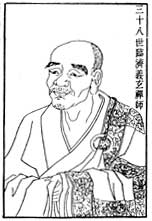The following is a bit edited from a note sent to someone researching approaches to creativity. I thought it might be worth posting here.
In classical Buddhism, as I understand it, emptiness, shunyata, means that nothing has an essence. Everything is constructed of things interacting, none of which have essences or an essence. Half a millenia later Nagarjuna is generally credited for clarifying or re-framing this insight as the two truths. The world of form is true. The world of emptiness is true.
In addition to emptiness and form, this insight has been called the absolute and the relative, real and illusory, true and partial, straight and bent, etc, etc. I like this variety of terms as the6 help us keep from settling into one frame, one way of thinking about what it is we’re encountering here.
And, and here’s the kicker. The great gift that Nagarjuna, perhaps, certainly someone noticed, and it is the insight which becomes the bases of a whole cycle of Buddhist literature, the Prajnaparamita sutras, summarizable as “form is emptiness, emptiness is form.”
And this dual reality is not static, it is wildly dynamic.
Over the years and centuries as this perspective has been explored, mapping it against lived human experience, we see how our lives are indeed dynamic, indeed wildly so, spinning out of the various ways we are right here living our lives with consequences for everything done or even thought, even as we see that everything in its wild motion is also empty, absolute, one. (One is itself somewhat problematic as some see in that phrase an implicit essentialism. But that belongs to a different discussion)
In Zen how these encounters happen are most exquisitely expressed by the ninth century Chinese Zen master Dongshan Liangjie in his Verses of the Five Ranks. Actually, probably “modes” is better here than “ranks,” as there is no actual hierarchy of experience – even though some perspectives are more painful for us as human beings than others.
While there are numerous possible permutations, Dongshan shows how five capture this dynamism exquisitely.
Form in emptiness
Emptiness in form
Coming from within the empty
Going within both empty and form
Arriving within both together
The Thirteenth century Japanese master Eihei Dogen observes in his Genjokoan essay, as translated by Robert Aitken & Kazuaki Tanahashi, “As all things are buddha-dharma, there are delusion, realization, practice, birth and death, buddhas and sentient beings. As myriad things are without an abiding self, there is no delusion, no realization, no buddha, no sentient being, no birth and death. The buddha way, in essence, is leaping clear of abundance and lack; thus there are birth and death, delusion and realization, sentient beings and buddhas. Yet in attachment blossoms fall, and in aversion weeds spread.”
Probing this perspective deeply, Dongshan’s verses on these ranks or modes are among the most important in Zen’s literature.
In Thomas Cleary’s translation.
Form in emptiness.
In the third watch,
beginning of the night,
before the moon is bright,
do not wonder
at meeting without recognition;
still held hidden in the heart
is the beauty of former days
Emptiness in form.
A woman who’s overslept
encounters an ancient mirror;
clearly she sees her face-
there is no other reality.
Nevertheless, she still mistakes
her reflection for her head
Coming from within the empty.
Within nothingness is a road
out of the dust;
just be able to avoid violating
the present taboo name
and you will surpass
the eloquence of yore
that silenced every tongue.
Going within both empty and form.
When two blades cross,
no need to flee;
an expert is like
a lotus in fire-
clearly there is a spirit
spontaneously soaring.
Arriving within both together.
in being or nonbeing,
who can dare to join you?
Everyone wants to leave
the ordinary current,
but in the final analysis
you come back
and sit in the ashes
These verses are examined closely at very nearly the end of formal koan study, at least within the Inzan line of Hakuin’s Zen curriculum as transmitted within the Harada Yasutani lineage.
If you’re looking to explore human creativity, this, I believe, is where you will find the Zen Buddhist take on the matter.













